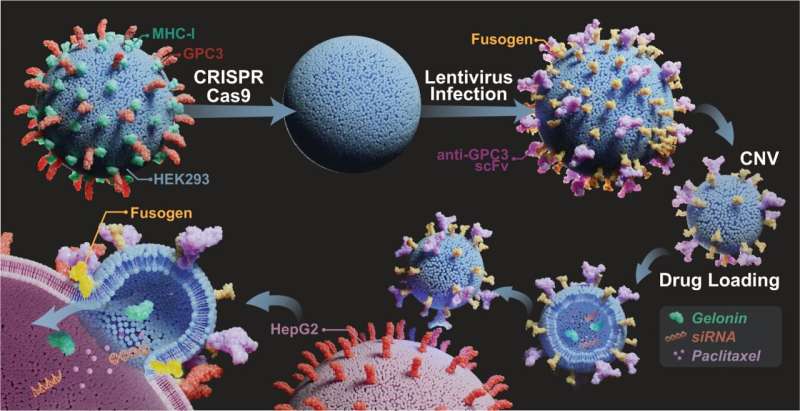
Schematic of anti-GPC3 scoff and engineered fusogen co-expressing eFT-CNVs for cytosolic delivery of therapeutics. Intrinsic GPC3 and B2M are knocked out using CRISPR/Cas 9 followed by co-expressing anti-GPC3 scFv and engineered fusogen on HEK293 cell membranes. The eFT-CNVs are generated by mechanical extrusion of the donor cells and loaded with various drugs, e.g., nucleic acids, protein toxins, or chemotherapeutic agents, for on-target cytosolic delivery. Credit: Nature Communications (2023). DOI: 10.1038/s41467-023-39181-2
Two unfortunate facts about chemotherapy: It can harm healthy cells as well as cancerous ones, and many therapeutic targets stay within cancer cells, making them harder to reach.
Binghamton University biomedical engineers are among those researching the use of cell-derived nanovesicles to deliver therapeutic agents to the interior of cancer cells with better accuracy and efficiency. The small sacks of proteins, lipids and RNA that cells secrete as a method of intercellular communication could be modified to carry medications.
“These nanocarriers have some excellent properties,” said Yuan Wan, an assistant professor in the Thomas J. Watson College of Engineering and Applied Science’s Department of Biomedical Engineering. “For example, they can be harvested from human cell strains, so the immune response is very low. That allows for optimal biocompatibility, so they evade immune clearance and have an extended blood half-life. The time for circulation around the body is maybe 45 seconds, so the drug-loaded nanovesicles can safely travel to the tumors many times and the drugs have more chances to be taken up by cancer cells compared to drugs freely introduced into the body.
“Large amounts of encapsulated drugs can be well protected and retained by the nanovesicles’ lipid membranes. Once cancer cells uptake these nanovesicles, high drug concentrations in the tumor microenvironment effectively kill cancer cells. In comparison, free drugs can diffuse quickly and then are cleaned from the body. Only a very tiny amount of drugs reaches the tumors, making treatment efficacy very low. You can increase the dose, but a higher dose also results in high systematic toxicity.”
In their new study, published in Nature Communications, the Binghamton team experimented with targeting moieties and engineered viral fusogens, which are proteins that facilitate cancer targeting and the fusion of cell membranes.
By identifying overexpressed or cancer-specific antigens that occur in malignant cells and using targeting moieties and fusogen co-equipped nanovesicles, encapsulated drugs are injected into cancer cells while leaving healthy cells alone.
“People widely use nanocarriers known as polymer-decorated liposomes, and they are already approved by the FDA,” Wan said. “But they are not perfect, because they do not have any cancer-targeting effect and may have very severe immunogenicity issues [triggering a response by the immune system].”
In 2021, Wan undertook research to test plasma-derived extracellular vesicles to diagnose whether solitary pulmonary nodules found in human lungs are benign or malignant. Other methods of determining malignancy either take too long or are more invasive.
By leveraging that knowledge, this current but separate research harnesses nanovesicles so they work for us and are specific in what they affect. Ideally, doctors could prepare these targeting moieties and fusogen co-equipped nanovesicles for use in safer vaccine delivery and genetic engineering.
As for what’s next, Wan said, “We need to show their treatment efficacy in large animal models and demonstrate that we don’t need a large amount of these vesicles because we’ll have the membrane fusion function. If you lower the number of vesicles and drugs you need, you lower the cost of the treatment and the side effects.”
More information:
Lixue Wang et al, Bioinspired engineering of fusogen and targeting moiety equipped nanovesicles, Nature Communications (2023). DOI: 10.1038/s41467-023-39181-2
Citation:
Research shows that genetically engineered vesicles better target cancer cells (2023, July 24)
retrieved 24 July 2023
from https://phys.org/news/2023-07-genetically-vesicles-cancer-cells.html
This document is subject to copyright. Apart from any fair dealing for the purpose of private study or research, no
part may be reproduced without the written permission. The content is provided for information purposes only.
>>> Read full article>>>
Copyright for syndicated content belongs to the linked Source : Phys.org – https://phys.org/news/2023-07-genetically-vesicles-cancer-cells.html































